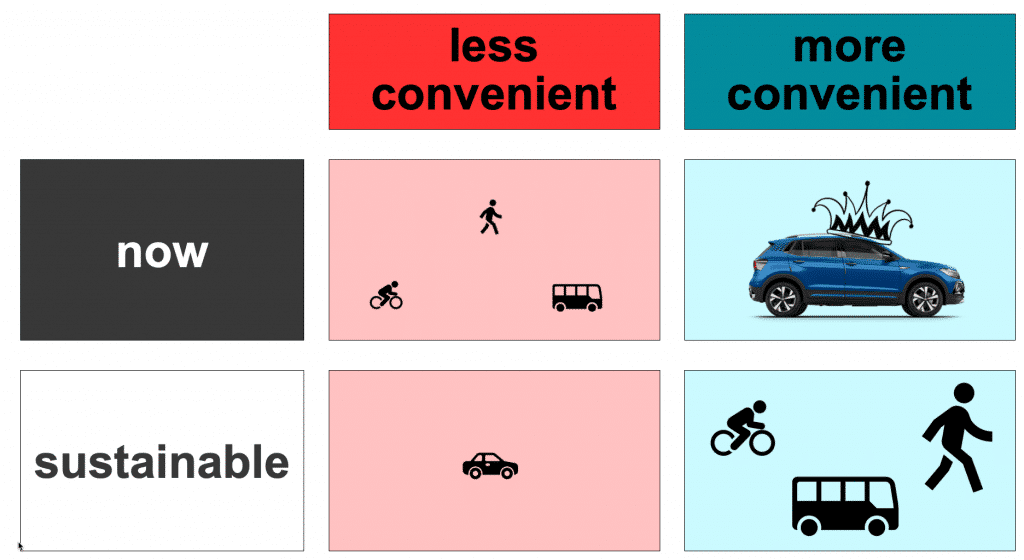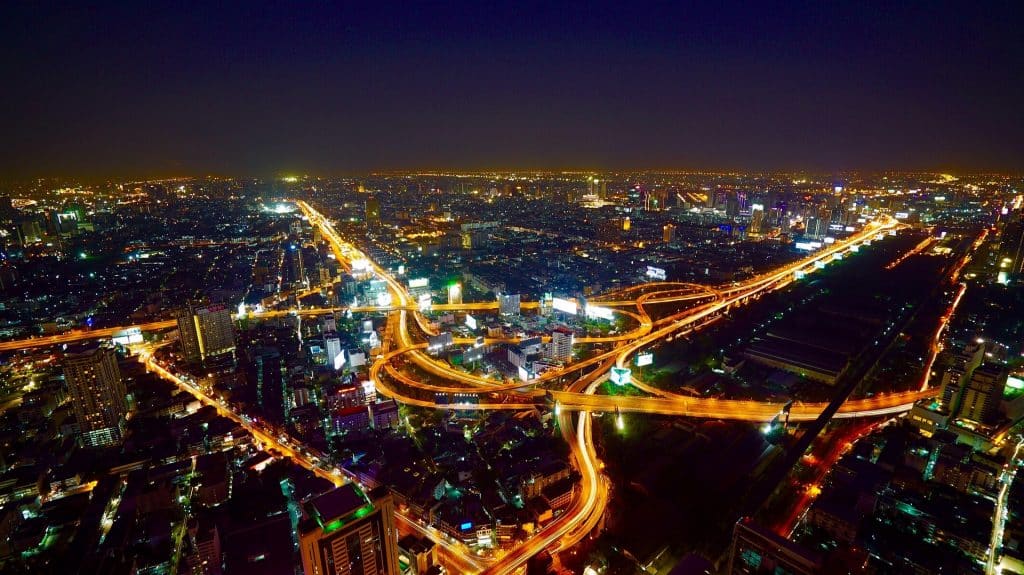“Yes, we have made them so,” says scientist Rafael Prieto-Curiel. As long as the paradigm persists that cars are the most comfortable way to get around, sustainable transport will have a hard time.
In 2019, the population grew by about 79 million people, while at the same time we produced 83 million cars. In Las Vegas, for example, 32% of the central part of the city is dedicated to car parking. Cities like Mexico City rely on pedestrian overpasses so that cars do not have to stop.
But what about Vienna, a city that has been awarded the world’s most liveable city several times? Here, too, we treat cars like royalty. Rarely do pedestrians have a similarly long green phase at the intersection as car drivers. And sometimes it’s downright stressful to reach the other side of the road in time. Driving a car is comfortable, driving a car is fast. “As long as that is the case, it will be difficult to get people to choose sustainable mobility,” explains Prieto-Curiel.

WHAT IS SUSTAINABLE MOBILITY?
Everyone has their daily journeys to make. The number of these journeys is roughly the same in different parts of the world in a normal week. However, there are forms of mobility that are more sustainable than others. “We currently know of only two sustainable types of mobility: active mobility such as cycling or walking, and a well-planned public transport network,” explains Prieto-Curiel.

For all these reasons, cars should not be the means of choice for getting around in cities. Nevertheless, the car is still on the rise. For example, in the US, you basically need a car to transport one person. In order to make sustainable forms of mobility more convenient and thus more attractive, the infrastructure must be expanded accordingly.
Therefore, the workshop “Sustainable Mobility: Data, Networks and Complexity” brought together researchers and policy makers from Vienna and Copenhagen to discuss strategies to make roads safer for cyclists and reduce car dependency.
THE WORKSHOP AT A GLANCE:
WHAT ARE THE CHALLENGES TO EXPANDING VIENNA’S CYCLING INFRASTRUCTURE?
Mobilitätsagentur Wien director Martin Blum shared some insights about the current situation in Vienna as well as strategies policymakers should keep in mind when expanding Vienna’s cycle paths. Vienna currently has around 1,600 km of cycling infrastructure. 50 new projects, 80 per cent of which are cycle paths or streets, are intended to make cycling even more attractive.

AN OPEN-SOURCE TOOL TO ACCESS VIENNA’S BIKE INFRASTRUCTURE DATA QUALITY
Anastassia Vybornova, from IT University of Copenhagen, demonstrated how to use BikeDNA, an open-source tool for bicycle infrastructure data assessment. She will also present an assessment of bicycle infrastructure data quality for data both from OpenStreetMap and from the City of Vienna’s Open Government Data.
HOW CITIES SHOULD PLAN CYCLE NETWORKS?
Michael Szell from IT University of Copenhagen showed how cities should plan cycle paths optimally. He simulated the cycle paths of 62 cities around the world – including Vienna – and found that it’s not how long the network is, but how you grow it.
HOW CAN CITIES ACHIEVE SUSTAINABLE MOBILITY?
Complexity Science Hub researcher Rafael Prieto-Curiel presented opportunities to achieve more sustainable mobility for different types of cities — including Vienna.
A NEW TOOL FOR OBSERVING MOBILITY IN CITIES
Anita Graser, from AIT, discussed MovingPandas, a Python library for movement data analysis that provides mobility data processing and analysis tools for analytics and data science workflows.
HOW FAR IS THE MOBILITY REVOLUTION IN VIENNA?
Ulrich Leth, from TU Wien, presented the existing gaps between the targets for a sustainable mobility in Vienna and the actual development, which is due to a mix of hesitant policy, insufficient measures, and a lack of resources.
UPSCALING THE TRANSFORMATION OF PUBLIC SPACE IN AUSTRIA
Barbara Laa, from TU Wien, discussed how to transform public spaces to create a sustainable and resilient transport system. Streets must give way to pedestrians, cyclists, public transport, and green infrastructure.
Cars cannot be sustainable, whether they are internal combustion or electric. Some reasons are:
- Cars require infrastructure (roads, car parks, …).
- Cars require large amounts of (non-renewable) raw materials and materials. We cannot recycle tires, for example, so they often end up in large landfills where they are burned. This smoke is so toxic that it would be too dangerous for firefighters to extinguish it.
- Car accidents lead to an estimated 1.3 million deaths a year.
- Driving increases inequalities (for example, more men than women drive and in some parts of the world only wealthy people can drive).
- Driving causes stressed drivers.


